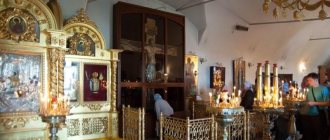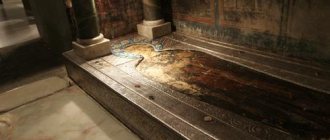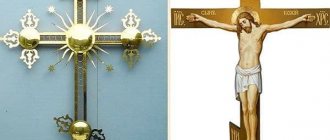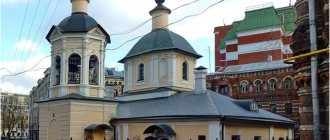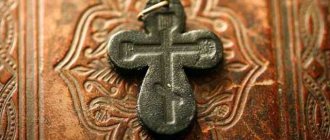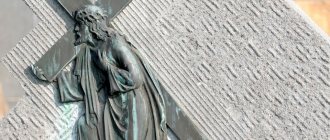It’s the 21st century, and everyone continues to ask: why did the cross become the main shrine of Christians? The cross is scary, gloomy, it seems like the end of everything. Many people thought so while watching the execution of Christ: they crucified him, period. But it turned out that there is such a continuation ahead...
On the cross, God not only died, but also rose again. Well, it’s almost like a grain: they threw it into the black earth, it died, but not only that: a whole ear of new grains grew from it, which will also give new life!
That is why Christians revere the Cross - the Christian God was crucified on it in order to resurrect and give a new, eternal life to his children. Was there another god in the history of mankind who, for the sake of people, “pathetic humanity,” would do such a thing? Or did he give his only son to die for men? More often the gods demanded sacrifices for themselves, and bloody ones.
In the “Prologue” there is a reflection on the Eternal Council of God preceding the creation of the world: “God the Father, All-Wise Love, turns to His Son, by whom all things must be created, and says to Him: Son, let us create the world! - And the Son answers: Yes, Father! - And the Father says to the Son:
but this world will fall away from Us into sin, and in order to save it, You will have to become a man and die... And the Son answers: So be it, Father!”
And Christ goes to the Cross, experiencing all the suffering and humiliation of this execution. And for some reason it does not leave him, as those gathered offer to look at the torment of the one who called Himself the Son of God. If He were the Son, and even more so the King, wouldn’t He be able to save himself from the Cross, defeat everyone and prove to everyone what the King of the Jews really is like! But he didn’t come down - everyone saw it - that means he’s a deceiver.
“Christ died on the cross in order to share with us the most tragic thing - death. He died because only death can express in the utmost sense love, giving oneself for the sake of another, writes Metropolitan. Anthony of Sourozh about the Cross of Christ. – We are not always ready to sacrifice our lives even for the sake of those closest to us. And God, Who is Life itself, so that we would not lose it forever, sacrificed his own.”
Christ was crucified outside the gates of Jerusalem, that is, outside human society, outside the city, as if a scapegoat expelled into the desert, upon whom the sins of ancient Israel fell and who was expelled to destruction outside the gates, outside the city, outside society; a chopped off piece... The immortal Son of God dies in the flesh.
Saint Gregory the Theologian says: what Christ did not partake of, He did not redeem...
He participated in everything, including the consequences of sin, which made man mortal and alienated him from God. He dies precisely in this horror of God-forsakenness: My God, My God, why have you forsaken Me?.. (Matthew 27:46) He dies from God-forsakenness...”
But Christ conquers death. God did not create death. Death appeared as a severance of connection with God. Death appeared when Adam, endowed with the “breath of life” given to him by God and therefore only living, wanted to become a god himself - secretly and without labor - he just had to do what was impossible, as those crawling by advised, and voila - god. Otherwise, you know, work in Paradise, prepare for deification. And in general - why not? Why am I worse?
Those who wanted independence got it. Only they themselves could do little - for example, they could not live forever, having interrupted the connection with the Source of eternal life. Autonomy did not happen.
Christ, unlike disobedient people, was obedient to the Father. Christ goes to death voluntarily in order to go through the same path of dying as a person. But death as a consequence of sin has no power over the sinless Christ. She, like the devil, “has nothing” of her own in Him. And therefore, the meeting of death by Christ becomes the defeat of death: having accepted the sin of the world upon Himself in baptism, the God-Man Christ cleanses human nature damaged by sin with His sacrificial blood.
And those who “have a part with Christ” enter into the resurrection not only by nature, but also personally.
Thus, the death of God turns out to be the resurrection of man, and the Cross turns out to be the Tree of Life. From now on, the dominion of death is over for those who want to be with God.
For Christians, the cross becomes a symbol of victory over evil, pain and death.
Which cross is correct?
At the festive all-night vigil for the Exaltation of the Cross (September 26), while singing “Holy God...” the priesthood carries the Cross into the middle of the church.
The cross is on the lectern for six days, until the celebration of the Feast, October 2. Photo from the website monastery.ru What exactly the Cross on which Christ was crucified looked like is unknown today. The Cross of the Savior, found, according to Tradition, by the holy Queen Helena, consisted of only two crossbars, a tablet with an inscription and a base.
In the history of the Church, there have been disputes about which cross is correct, for example, four or eight-pointed? On this occasion St. John of Kronstadt wrote: “The main thing that should remain in the Cross is Love. Where the Cross is, there is love. In church you see crosses everywhere and on everything so that everything reminds you that you are in the temple of Love crucified for us.”
Archaeologists have figured out exactly how Jesus Christ was crucified
Jesus was not crucified as depicted in all paintings
Nails in the heels
Numerous artists who have depicted the crucified Jesus Christ for centuries have been wrong. Already the second archaeological discovery testifies: the nails with which the executioners nailed the body of the Savior to the cross are located on the paintings in the wrong places where they should be. The feet of the crucified were not pierced in the area of the metatarsal or tarsal bones, as is depicted in almost everyone. In fact, the legs were secured with one nail that passed through both heels - or rather, both heel bones. Characteristic damage in these places is present on the discovered remains - on the bones of people who died on crosses at the beginning of the first century AD. It was at this time that Jesus Christ was executed.
The first material confirmation that crucifixion as a cruel and painful execution really existed was received only in 1968. Then, in one of the burials in Jerusalem, archaeologists found two heel bones, fastened with an iron nail, on which a piece of wood was preserved. The nail was approximately 18 cm long, the piece of wood was 2 cm long. In 1985, the discovery was described in detail by the late Greek archaeologist Vassilios Tzaferis in the journal Biblical Archaeology Review in an article entitled Crucifixion—The Archaeological Evidence.
Nail-pierced heels found in Jerusalem.
According to Tzaferis, the bones belonged to a noble Jew, about 25 years old, who was crucified for some political crime. That is, for treason against Rome.
And recently, in the journal Archaeological and Anthropological Sciences, a description of a second similar find appeared - essentially the second material confirmation of the reality of the crucifixion. Italian scientists from the Universities of Florence and Ferrara reported on the results of a study of a skeleton discovered in northern Italy 60 kilometers from Venice during excavations in 2006-2007, which took place at the site of ancient burials.
Skeleton of a crucified man found near Venice.
The skeleton belonged to a man a little over 30 years old, who died and was buried about 2 thousand years ago. One of his heels is broken - the right one. Punched through - about the same as that of a victim of political repression from Jerusalem. There was, however, no nail. But archaeologists, having examined the holes - the entrance with a diameter of 9 millimeters and the exit with a diameter of 6.5 millimeters, nevertheless risked suggesting that the “Italian” was crucified. For some reason, he was “fixed” by only one heel. The nature of the damage to the bone indicated that it had been nailed to some hard surface.
In Jerusalem the nail had a rectangular cross-section, near Venice it had an oval cross-section. Archaeologists claim that it was precisely this type of fastener that was common in those places about 2 thousand years ago.
Holes in the heel of the Roman.
Model of a heel pierced with a nail. Heel from a Roman skeleton.
The place where the skeleton of a crucified Roman was found.
Nails in wrists
Italian archaeologists claim that “their” crucified man had characteristic injuries on his hands. They testify that the hands were nailed with nails piercing the wrists. What's in the paintings? Painters - again en masse - depict the crucified Jesus Christ with pierced palms. That is, they are wrong here too.
One example: Rubens depicted nails in the wrong place.
The fact that a person nailed to a cross by the palms of his hands will not last long on the cross was proven back in 1931 by the French surgeon Pierre Barbey. He experimented with the blessing of the Vatican and found out that under the weight of the body, the palms would very soon tear. But the wrists are much stronger in this sense.
It took several decades for the “medical discovery” to find at least one archaeological evidence - the same skeleton with holes in the heel and wrists, examined by the Italians - the descendants of the ancient Romans.
By the way, Vasilios Tzaferis, who described the “first crucified”, absolved them - the ancient Romans - of the accusation that they were the ones who invented execution by crucifixion. He assured that even in the first millennium BC, the Assyrians, Phoenicians and Persians committed atrocities in a similar way.
The “correct” position of the legs of an executed person according to archaeologists.
Traces on the Shroud of Turin
The Shroud of Turin is a linen cloth 437 centimeters long and 111 centimeters wide, which is kept in the Cathedral of John the Baptist in the Italian city of Turin. On the canvas there are two negative typos of the human body with signs of mutilation - in front and behind.
Some believe that it was in this cloth that the Savior, taken from the cross, was wrapped and placed in the coffin, whose body was imprinted on the cloth in a supernatural way. It “appeared” as if on photographic film during the process of resurrection.
Skeptics suspect that the shroud is fake after all. That is, the image on it, if not drawn, was somehow obtained artificially.
Skeptics point to a 1988 study in which three independent laboratories radiocarbon dated the fabric. And they came to the conclusion that the shroud was made in the period from 1260 to 1390. That is, it cannot be real. After all, Jesus Christ was crucified in 33 AD.
On the shroud there are images of numerous wounds received by the Savior before his death. The figure has pierced wrists. Which is archaeologically true, as has now become clear thanks to Italian scientists. This “detail” is in favor of the authenticity of the shroud. But the wounds on the legs are “wrong” - not in the heels. Which gives skeptics another reason to doubt the authenticity of the relic.
Emanuela Gualdi from the University of Ferrara, who examined the skeleton of a crucified man that was found near Venice, believes that the heels of the executed person were nailed to the vertical post of the cross in two ways. The first - both feet are turned in one direction, the second - the feet are turned in different directions. In any case, there was only one nail: the heels were combined and pierced at once. He allowed the victim to lean on him and thereby prolong her torment.
About the research of traces of blood found on linen, which may have become a burial cloth for Jesus Christ, read: The most convincing evidence of the authenticity of the Shroud of Turin has been obtained
A LITTLE EARLIER
Have the nails that nailed Jesus Christ to the cross been found?!
The Italians explained why there are holes from nails in the skeleton of “their” crucified man, but there are no nails themselves. Researchers claim that the nails from the crucifixion were not placed in graves, but were preserved. They were believed to have magical powers.
This scientific revelation lends more credence to a claim made by archaeologist, journalist and documentary filmmaker Simcha Jacobovici in his 2011 documentary The Nails of Christ.
Yakubovichi claims: two nails with rounded heads about 8 centimeters long, curved at the ends, which were discovered in 1990 in a grave accidentally dug up by construction workers in the Abu Tor area of Jerusalem, are the same ones. They nailed the hands of Jesus Christ.
Yakubovichi with one of the “nails of Jesus Christ.”
The grave - a family burial about 2 thousand years old - was located in a cave. Inside there were stone burial boxes - ossuaries. One of them was engraved with the inscription “Joseph bar Caiaphas.” Inside are the bones of a 60-year-old man. One nail lay among them, the other next to the box.
According to researchers, this “Joseph bar Caiaphas” could well be the same Caiaphas, the high priest, into whose hands the arrested Son of God fell (“...Annas sent him bound to the high priest Caiaphas,” John 18-24).
Jacobovici is sure that the high priest kept the nails and even took them with him to the grave, because they were of great value. That is, they were not just from the crucifixion, but from the crucifixion of Jesus Christ.
The nails, which were removed from the burial in 1990, for some reason were not included in the official list of items handed over to scientists. And they disappeared.
Found in 2011 in one of the laboratories of Tel Aviv University. The fact that they are the same ones - from the grave of the “high priest” - was then confirmed by Israel Hershkovitz, professor of the Department of Anatomy and Anthropology at Tel Aviv University. But are the nails really from the Savior’s crucifixion? Who knows... What if? Israeli archaeologists do not deny that the tomb of the high priest Caiaphas was actually found in the Abu Tor area.
Both nails are from the tomb of the high priest Caiaphas.
HELP "KP"
Caiaphas was appointed high priest in 18 by order of the Roman governor Valerius Gratius. Pontius Pilate, who replaced him, did not appoint a new one - he left in this post the rich and influential Caiaphas, who was married to the daughter of Anna, the head of a powerful clan.
Caiaphas was the head of Sendrion, the religious council in Jerusalem. It was Caiaphas who advocated killing Jesus. He was afraid that his teaching would raise the people to revolt, the Romans would suppress him, killing many people, and Caiaphas himself would be removed from office (“From that day they decided to kill Him,” John, 11, 53).
Caiaphas served until the age of 36. In 37 it was removed by the governor of Syria, Lucius Vetelius. But the former high priest remained very influential. Died at the age of 60.
What is the power of the cross?
Dudin Monastery.
Photo by Vagant1221 from wikimedia.org Prot. Vsevolod Shpiller :
“The cross is an image of the Holy Trinity, God the Father, God the Son and God the Holy Spirit. But what does image mean? We know that an icon is an image of God. Not God Himself, but His presence, His properties. So in the Cross of the Lord there are properties of God, the Most Holy Trinity itself. What are these properties?
God is love. And this Love was revealed first in the Incarnation of God, then in the entire earthly life of Jesus Christ. But its special appearance was on the Cross, on which He allowed Himself to be crucified. The crucifixion of the Lord on the tree of the cross is a great sacrifice for the sins of people.
And the Cross, which is the image of this love, also has in itself the power of this Love. This compassionate, compassionate love gives man communion with the Divine.
When we worship the image of the Most Holy Trinity - the Cross of the Lord, we kiss it, as if we are touching the hem of Christ’s robe, as the bleeding wife did.
And the power that is in Christ, the warmth of a repentant person makes a partaker of the Divine Himself, of the Divine Light, leads to a change in that sinful nature, which turns out to be worthy of the resurrection, and the ascension, and even sitting at the right hand of God the Father. This is what the Cross gives us, this is what compassionate divine love gives to a person who warmly repents.”
Tradition of crucifixion
Actually, the Romans crucified in different ways. We have a lot of evidence that this type of execution was not always classic. For example, when a huge number of people had to be crucified, anything could be used for this: pillars, trees, house walls, doors.
When examining the Shroud of Turin, it was discovered that the nailing of the hands occurred in the wrist area. And a fragment of a heel bone found in Palestine in the burial of a crucified youth tells us that they could have nailed their feet with one large nail into the heel bone through wooden planks. Perhaps this is the end of the artifacts testifying to the ancient execution of the Romans, which they adopted from the Carthaginians.
But the main thing in this execution was the killing itself by strangulation. This was the principle of fanaticism on such a terrible gallows! Crucifixion has always been the most shameful execution.
Usually they crucified people naked, often pouring excrement or slop over their bodies so that a swarm of flies would overcome the unfortunate people. Stones were often thrown at those crucified, multiplying the bleeding wounds. Vile performances were staged under the martyrs on the crosses, with which the dignity of man was humiliated.
Execution on the cross testified to the complete helplessness of the executed. In ancient times, the helpless were not loved, they became objects of attack and humiliation.
Foreskin of Jesus Christ
If the Holy Grail is the most coveted relic, then the foreskin of Jesus is certainly the most unusual. The foreskin (or prepuce) is a product of the Circumcision of the Lord, or in simple words, part of the skin of Christ’s penis. Numerous monasteries and churches have declared and continue to declare that they have a sacred prepuce, and numerous miraculous properties are attributed to the relic itself. According to some reports, there are as many as 18 preputies in the world, but officially, the church does not recognize any of them.[10][11]
Veronica Plat
Veronica Plat
Veronica's Veil (Veil of Veronica) is a miraculous image of Jesus Christ, which, according to legend, appeared on the scarf that Saint Veronica gave to Jesus Christ when he carried his cross to Calvary. The history of this relic is quite ambiguous, because the first mentions of it are found only in the Middle Ages. In the Middle Ages, many copies of the scarf were created, until in 1600 the Pope issued a ban on its copying.
According to legend, the true Plath of Veronica is kept in the Cathedral of St. Peter's in Rome. This is a thin fabric in which the image of the face of Jesus Christ can be seen in the light. The Vatican calls the Plata Veronica the most valuable relic of Christianity, which is kept in St. Peter's Basilica. In 1628, Pope Urban VIII issued a ban on public display of the painting, and since then it has been removed from the column for public viewing only once a year - on the fifth Sunday supper of Lent. The display time, however, is limited, and the board itself is shown from the high loggia of the Pillar of St. Veronica. Only canons of St. Peter's Basilica are allowed to approach the relic.[4]
Veronica's Plaid shown from the balcony of St. Peter's Basilica
crown of thorns
The crown of thorns is a crown of plant branches with thorns, which, according to the Gospels, was placed on the head of Jesus Christ by Roman soldiers during His reproach. Today, the relic, revered as the Crown of Thorns of God, is located in Paris, in the Cathedral of Notre Dame de Paris. Despite numerous studies, the authenticity of the crown could not be proven. The relic is displayed on every first Friday of the month, Good Friday, and every Friday of Lent.[5]
crown of thorns
Holy Grail
The Holy Grail is the cup from which Jesus Christ ate at the Last Supper and into which Joseph of Arimathea collected the blood from the wounds of the Savior crucified on the cross. Despite the titanic efforts of many generations of researchers, the Holy Grail was never found.
Conspiracy theorists claim that the word “grail” refers to the blood of Jesus’ descendants. According to other researchers, the Holy Grail may mean the breast of Mary Magdalene.[9]
Sir
Sir
Sudar (from Latin sudarium - “handkerchief for wiping sweat from the face”) - a handkerchief that was used to cover the head of Jesus Christ after death. There are no images on the material, but its surface has absorbed extensive blood stains. According to some studies, the blood stains on the sudar closely match the shape of the corresponding stains on the Shroud of Turin (see below), which may indicate that both materials covered the same body. The relic is kept in the Camara Santa Chapel of the Cathedral of San Salvador in Spain, and is displayed three times a year.[6]
Casket with the sir in Oviedo
